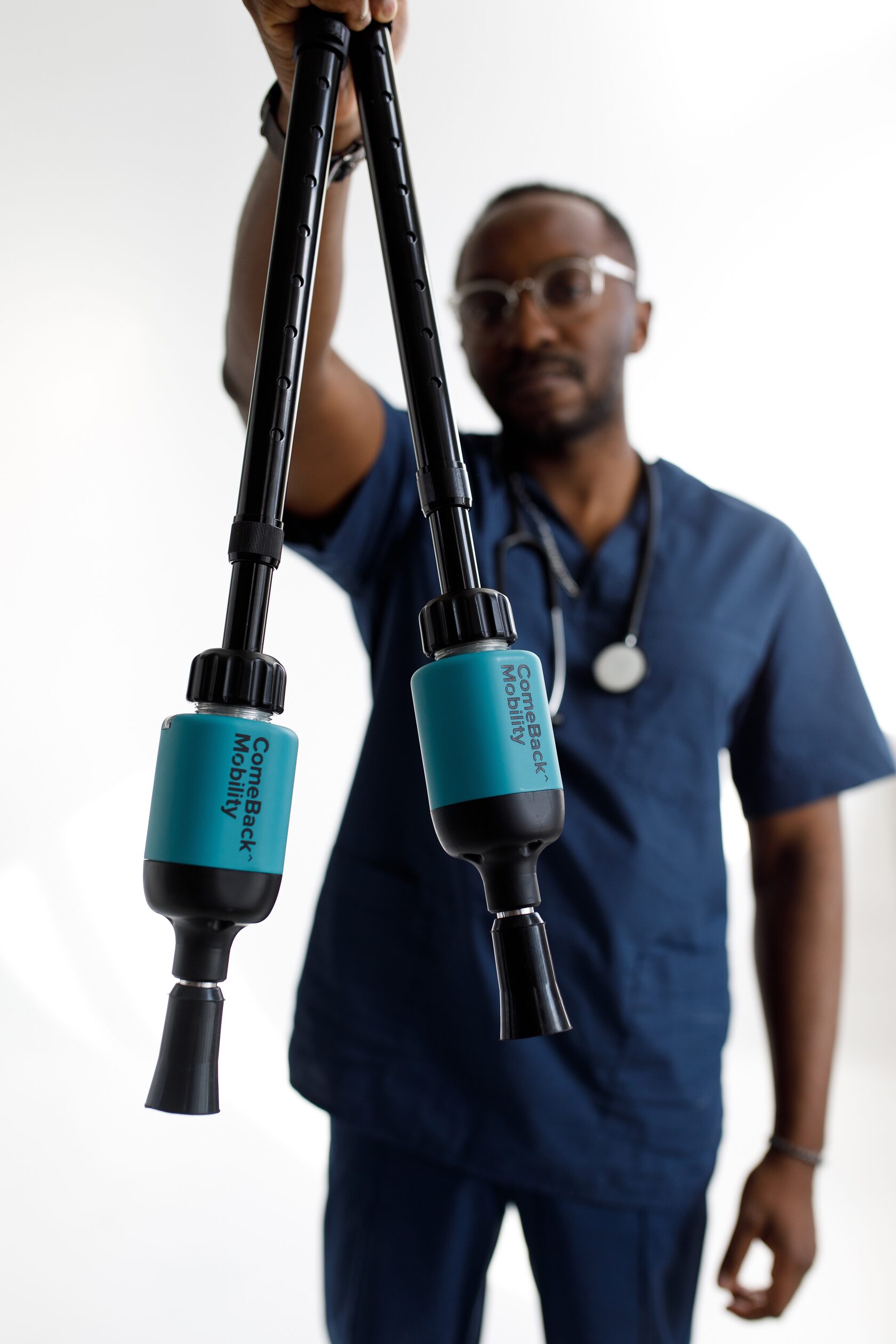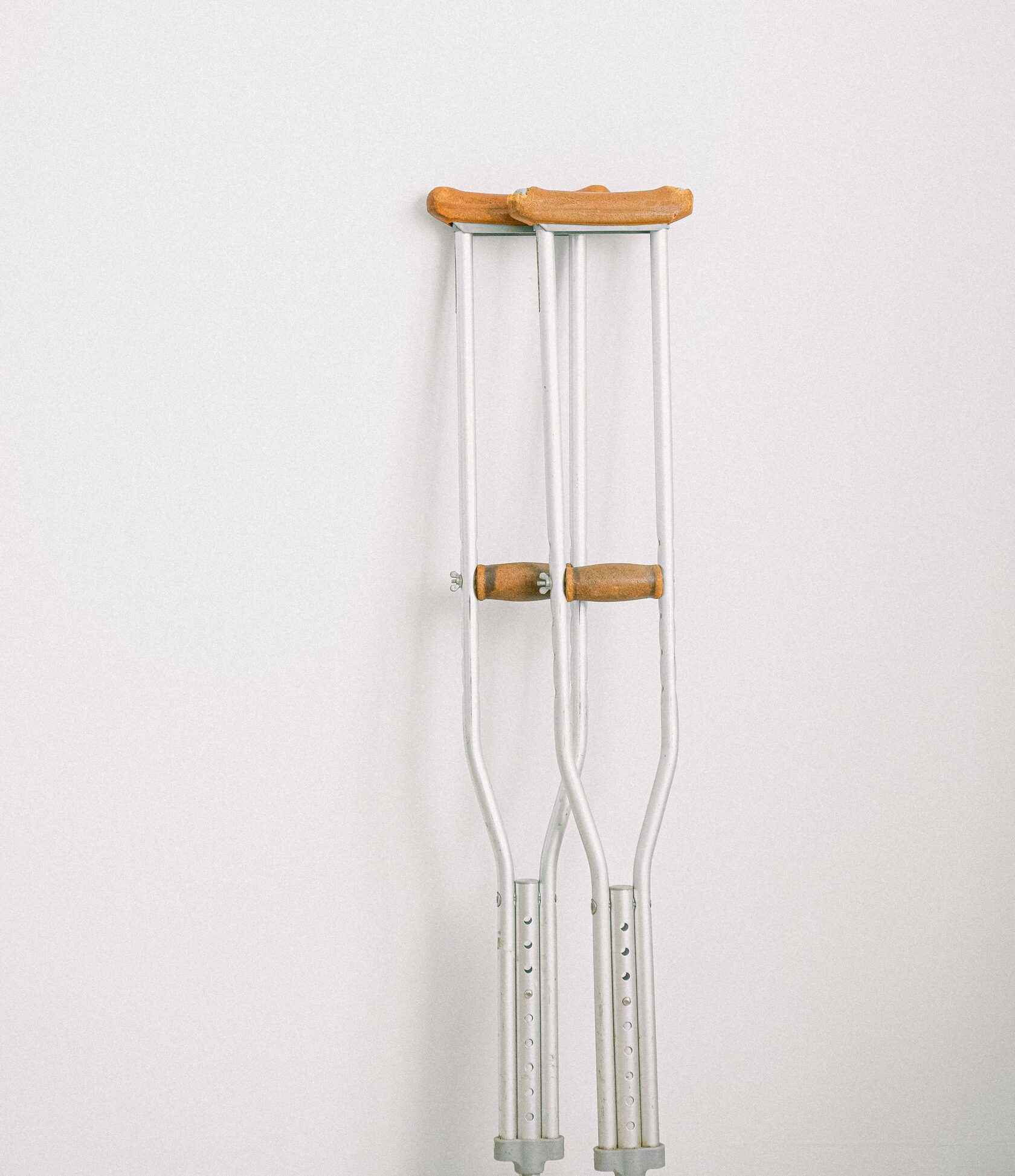Crutches protect and assist your body during rehabilitation for a lower extremity trauma or surgery. For crutches to function properly, they need to be fitted according to the patient’s height.





If they are not properly adjusted, there is an increased risk of placing too much weight on the injured leg, increasing pain, tension, or swelling in the injured leg, and unnecessarily placing too much stress on your arms. If one is not careful with crutch positioning and sizing, you can even injure the armpit and/or hand nerve. That is why a healthcare provider needs to do the initial crutch fitting for you.
Crutch fitting: Where to start from?
After your orthopedic evaluation and diagnosis for an injury, a rehabilitation healthcare professional will consult you on what assistive device best suits your rehabilitation treatment plan. You will be properly fit with the assistive device which can include a walker, crutches, or a cane.
If you are having a planned surgery, it is beneficial to make a list of questions you would like to clarify regarding your treatment plan and the use of assistive devices such as crutches. This approach may save you time and provide conversation cues when you have an appointment with the orthopedist.
In some clinics, physical therapists provide assistive device fittings and instructions prior to surgery. This allows the patient to focus on the crutch fitting and use instructions without surgical pain and mobility limitations.

After your orthopedic evaluation and diagnosis for an injury, a rehabilitation healthcare professional will consult you on what assistive device best suits your rehabilitation treatment plan. You will be properly fit with the assistive device which can include a walker, crutches, or a cane.
If you are having a planned surgery, it is beneficial to make a list of questions you would like to clarify regarding your treatment plan and the use of assistive devices such as crutches. This approach may save you time and provide conversation cues when you have an appointment with the orthopedist.
In some clinics, physical therapists provide assistive device fittings and instructions prior to surgery. This allows the patient to focus on the crutch fitting and use instructions without surgical pain and mobility limitations.






Also, the patient has a chance to practice using the assistive device prior to rehabilitation, giving them more confidence with the crutches during rehabilitation.
Home sweet home





Once you are home and are faced with a situation when you need to size and adjust your crutches by yourself, you can do that using the following recommendations.
Simple tips to remember:
To size crutches in accordance with your height, you need to stand still in your shoes (the shoes must be without heels). In this position, the crutch pad is 1-2 inches below your armpits or two to three fingers width between armpit and crutch pad. Most axillary crutches have suggested height notches in the base of the crutch. However, based on footwear, it is smart to check the distance between the armpit and crutch pad to ensure proper positioning.[1]
When crutches are properly adjusted, the crutch handgrips are level with your wrists.[2]
Elbows are slightly bent (about 30 degrees) when you hold the crutch handgrips
The crutches are positioned one at each side of your body (in this case, crutches form a 90 degrees angle with the surface). This position adds steadiness and correct weight-bearing distribution between your arms, healthy leg, and injured leg (depending on your prescribed weight-bearing status.
Crutch height is adjusted by pushing the pins at the bottom of the crutch, and crutch hand grip is adjusted by unscrewing the lug nut and replacing the handgrip at the correct level.
When walking with crutches you should have an upright posture.
What if the crutches are too short or too long?

If your crutches are too long, the crutch pad is jammed into your armpit pushing your shoulders upwards. In this situation a person looks like they have a shorter neck. This unnatural position creates additional stresses on the shoulders and can impinge the nerves in your armpit.[2]
As you strain to walk with too high crutches, your elbows will be more extended, or straighter, versus having a gentle 30-degree angle bend. This can lead to several negative outcomes: Firstly, it is rather difficult to walk, especially for a long period of time, in this improper position described above. You will fatigue quickly. Secondly, because of the unnatural position, you are at risk of developing pain in the upper body (the shoulders, neck, etc.)[2]
Thirdly, the decreased elbow angle leads to a decrease in the arms’ mechanical advantage, or ability to support the body’s weight on crutches. Thus, you may have difficulty distributing your body weight among your arms while walking. This means that more weight is placed on the injured leg, potentially increasing the risk of complications.
What if the crutches are too short or too long?

If your crutches are too long, the crutch pad is jammed into your armpit pushing your shoulders upwards. In this situation a person looks like they have a shorter neck. This unnatural position creates additional stresses on the shoulders and can impinge the nerves in your armpit.[2]
As you strain to walk with too high crutches, your elbows will be more extended, or straighter, versus having a gentle 30-degree angle bend. This can lead to several negative outcomes: Firstly, it is rather difficult to walk, especially for a long period of time, in this improper position described above. You will fatigue quickly. Secondly, because of the unnatural position, you are at risk of developing pain in the upper body (the shoulders, neck, etc.)[2]
Thirdly, the decreased elbow angle leads to a decrease in the arms’ mechanical advantage, or ability to support the body’s weight on crutches. Thus, you may have difficulty distributing your body weight among your arms while walking. This means that more weight is placed on the injured leg, potentially increasing the risk of complications.





Helpful Tip: A seemingly innocent wrong crutch fitting can have a significant negative impact on the injured leg’s rehabilitation. By replacing the standard crutch tips with ComeBack Mobility Smart Crutch Tips, you always know how much weight you are placing on your leg despite the crutch fitting.
ComeBack Mobility Smart Crutch Tips





ComeBack Mobility developed a product that can effectively address the problem of adhering to a prescribed weight-bearing restriction during rehabilitation. The Smart Crutch Tips provide patients with real-time audio, visual, and vibration biofeedback in response to steps taken while crutch walking. The gait data is recorded in real time and is accessible for the patient on the Patient App and for the doctor/ rehabilitation specialist on the Doctor App. The doctor can review your gait compliance level on his dashboard and reach out to you if there are any concerning trends. Likewise, the patient can reach out to the doctor via the SOS button with any concerning symptom changes and presentations.
Now that innocent wrong crutch fitting will be innocent – at least regarding the loading of your injured leg. ComeBack to mobility.
How Does It Work?
The patient applies load to the injured leg as prescribed by their attending physician. In case of non-compliance, they receive instant notifications from the devices
Data about patient’s weight bearing status, compliance, daily steps, and concerns are sent to the physician’s phone or PC
The doctor monitors how the patient loads the involved leg and adjusts the weight bearing status if necessary
SOURCES
- Patient compliance with touchdown weight bearing after microfracture treatment of talar osteochondral lesions
- Patient compliance with postoperative lower extremity touch-down weight-bearing orders at a level I academic trauma center
- (PDF) Weight Bearing Compliance after Foot and Ankle Surgery
- Factors Affecting Compliance With Weight-Bearing Restriction and the Amount of Weight-Bearing in the Elderly With Femur or Pelvic Fractures
- Application Of Calculating The Maximum Permissible Load On The Femur After Osteosynthesis
- Current advances in training orthopaedic patients to comply with PWB instructions
- Force Plates – Do you need one?
- Different in-shoe devices for partial weight bearing
- Effectiveness of a Simple Auditory Feedback Insole






